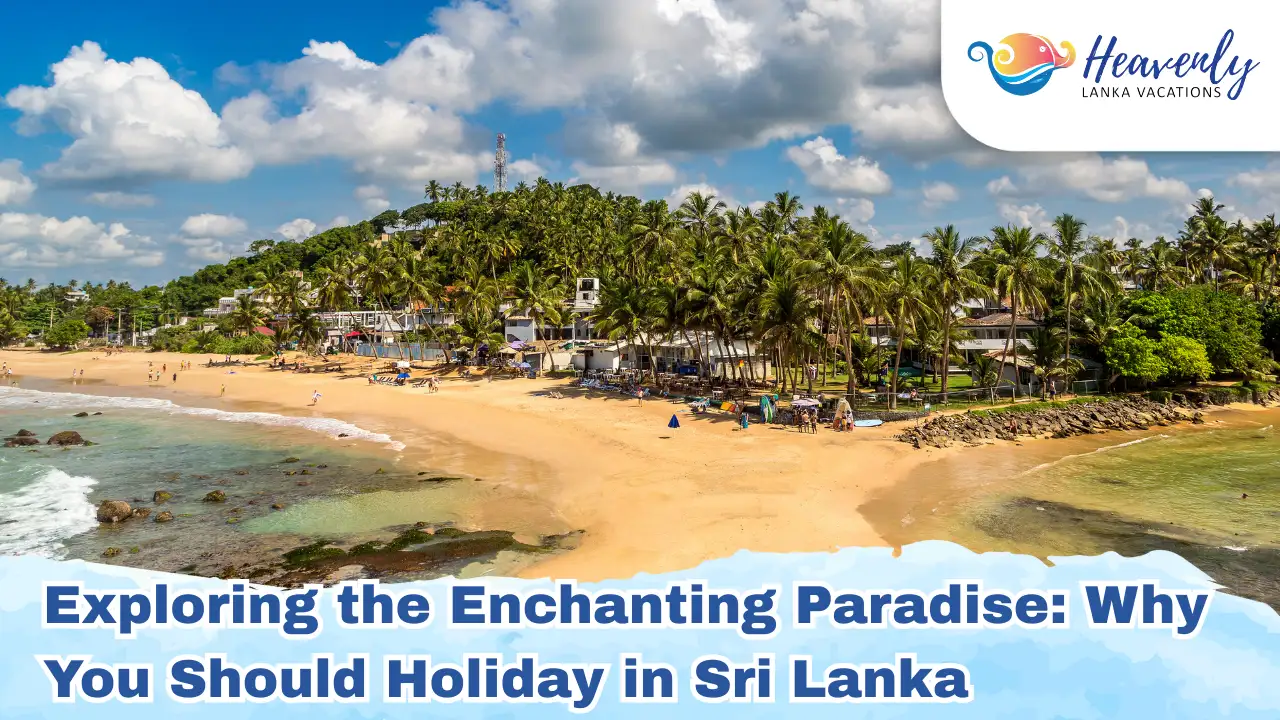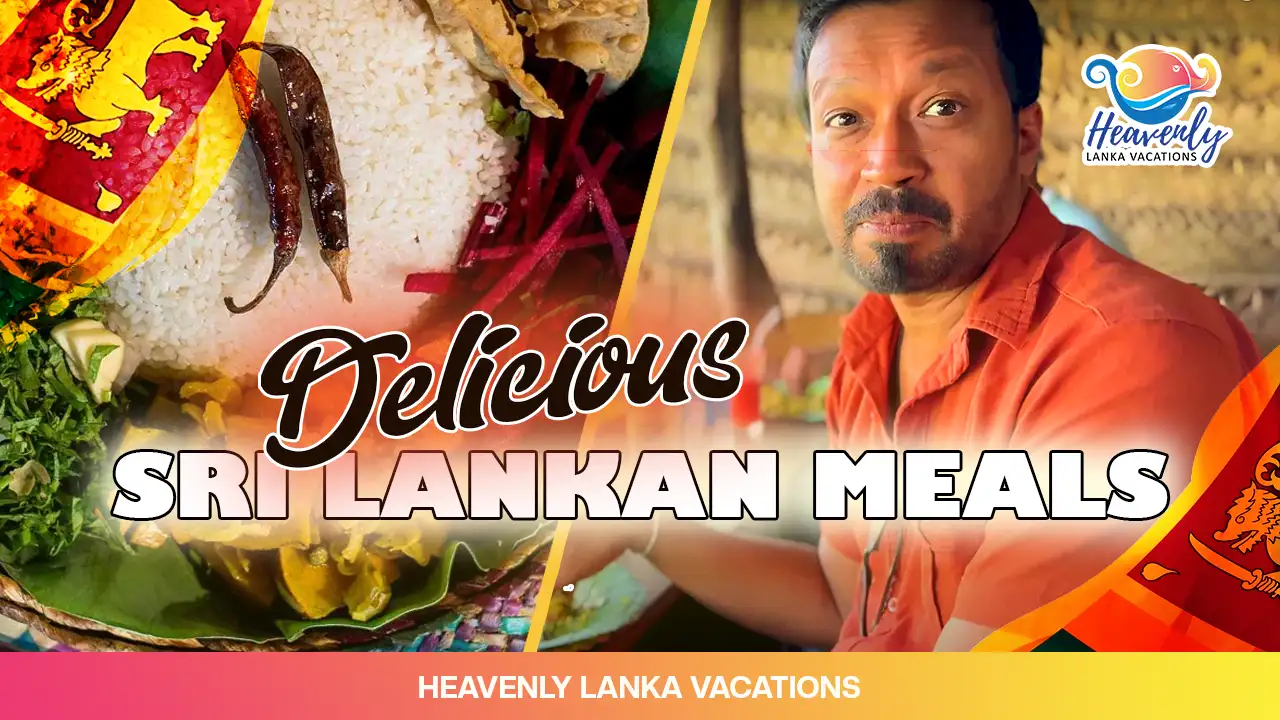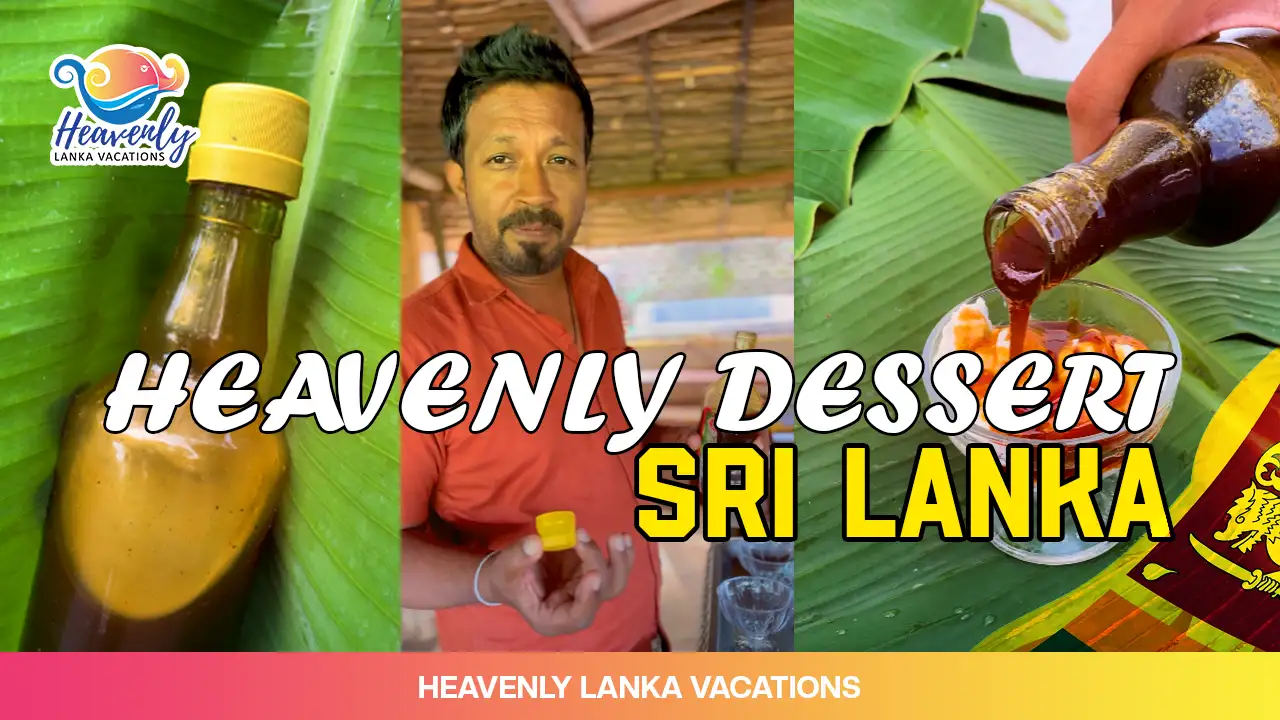Introduction
Sri Lanka, often referred to as the “Pearl of the Indian Ocean,” is a breathtaking island nation with a rich tapestry of culture, history, and natural beauty. Nestled in the Indian Ocean, this tropical paradise has been gaining immense popularity among travelers in recent years.
The island of Sri Lanka measures about 255 miles (415 km.) from north to south, and about 135 miles (220 km.) from east to west, with a total land area of about 25,300 square miles (65,600 square km.).
There are numerous compelling reasons why you should consider Sri Lanka as your next holiday destination. From its pristine beaches to its ancient temples, lush rainforests, and welcoming local culture, Sri Lanka offers a unique and enriching travel experience.


- Diverse and Enchanting Landscapes
Sri Lanka boasts an incredibly diverse range of landscapes, all within a relatively small area. Whether you are an adventurer, a nature lover, or someone seeking relaxation, Sri Lanka has something to offer. The country is home to lush tea plantations in the central highlands, serene beaches along its coastline, misty mountains, and dense rainforests filled with exotic wildlife. The unique geographical features of Sri Lanka ensure that every traveler finds something that captivates their senses.
- The Coastal Belt:
Sri Lanka’s coastline stretches for approximately 1,600 kilometers, featuring an array of stunning beaches. The coastal belt is divided into west and east coasts, with each having its own charm. The west coast, including locations like Negombo and Bentota, offers tranquil waters and ideal conditions for water sports. The east coast, with destinations such as Trincomalee and Arugam Bay, is famous for its pristine beaches and surfing hotspots.
- The Central Highlands:
The central highlands of Sri Lanka are a treasure trove of stunning landscapes. The region is characterized by lush tea plantations, rolling hills, and cool temperatures. The city of Nuwara Eliya is often referred to as “Little England” due to its colonial influence and is a gateway to exploring this beautiful region. The central highlands are also home to Sri Lanka’s tallest peak, Pidurutalagala.
- The Cultural Triangle:
Located in the northern central plains, the Cultural Triangle is a UNESCO World Heritage Site and home to ancient cities and archaeological wonders. This region includes Anuradhapura, Polonnaruwa, and Sigiriya, offering a glimpse into Sri Lanka’s rich history and cultural heritage.
- The Dry Zone:
Sri Lanka’s northern and north-central regions fall under the dry zone, characterized by arid landscapes and scrub forests. These areas include national parks like Wilpattu, which are excellent for wildlife safaris and offer a unique contrast to the lush greenery in other parts of the island.


- The Hill Country:
The hill country, situated in the central highlands, offers breathtaking scenery, cooler temperatures, and is famous for its tea plantations. Towns like Kandy, Ella, and Haputale are popular destinations for travelers seeking serene landscapes and outdoor adventures.
- The Northern Peninsula:
The northern peninsula of Sri Lanka is less frequented by tourists but offers unique cultural and historical experiences. The city of Jaffna, in particular, is known for its distinctive culture and cuisine.
- The Rainforests:
The southwestern region of Sri Lanka, particularly the Sinharaja Forest Reserve, is a UNESCO World Heritage Site and home to lush rainforests. This area is known for its high biodiversity, with numerous endemic species of plants and animals.
- Pristine Beaches
With over 1,600 kilometers of coastline, Sri Lanka is blessed with some of the most beautiful and pristine beaches in the world. From the golden sands of Mirissa and Unawatuna to the surfing hotspots in Arugam Bay and the tranquil shores of Trincomalee, Sri Lanka has a beach for every taste. These beaches offer a variety of water activities such as swimming, snorkeling, and whale watching, making them perfect for those seeking both relaxation and adventure.

Mirissa Beach: A Serene Retreat
Nestled in the southern part of Sri Lanka, Mirissa Beach is a serene and tranquil escape. It’s famous for its golden sands and calm, turquoise waters. The laid-back atmosphere is perfect for those seeking relaxation, yoga retreats, and watching mesmerizing sunsets. Mirissa is also known as one of the best places for whale and dolphin watching, making it a destination for nature enthusiasts.
Unawatuna Beach: Beach Lover’s Paradise
Located close to the historic town of Galle, Unawatuna Beach boasts a horseshoe-shaped bay with clear waters. It’s a paradise for beach lovers and water sports enthusiasts. The beach is lined with restaurants and beachfront bars, offering a vibrant social scene for those who enjoy both the sea and nightlife.
Arugam Bay: Surfer’s Haven
On the east coast, Arugam Bay stands out as a mecca for surfers. This coastal town is renowned for its consistent waves, attracting surfers from around the world. The relaxed atmosphere and pristine beaches provide the ideal backdrop for both beginner and advanced surfers.
Trincomalee: Pristine Shores and Marine Wonders
Trincomalee, on the northeastern coast, offers some of the most pristine and less-explored beaches in Sri Lanka. Uppuveli and Nilaveli beaches are known for their soft white sands and calm seas. The region is also a gateway to exploring the Pigeon Island National Park, an excellent spot for snorkeling and diving, where vibrant coral reefs and marine life await.
Bentota: Water Sports Extravaganza
Located along the west coast, Bentota is renowned for its water sports. The Bentota River and lagoon offer opportunities for jet-skiing, water-skiing, windsurfing, and boat safaris through mangrove forests. The town’s long, sandy beach is perfect for swimming and sunbathing.
Hikkaduwa: Vibrant Beach Town
Hikkaduwa, situated on the southwest coast, is known for its vibrant atmosphere. The coral reef just offshore makes it a great spot for snorkeling and diving. The town also offers a lively nightlife, with beachfront bars, restaurants, and a vibrant arts scene.
Kalpitiya: Kitesurfing Paradise
Kalpitiya, in the northwestern part of Sri Lanka, is a rising star in the world of kitesurfing. The vast lagoon, consistent winds, and shallow waters make it an ideal destination for kitesurfers of all levels. The region also offers dolphin and whale watching opportunities.


Rich Cultural Heritage
Sri Lanka’s history dates back over 2,500 years, and this heritage is vividly preserved in the country’s ancient cities, temples, and ruins. Explore the UNESCO World Heritage sites of Sigiriya, Polonnaruwa, and Anuradhapura to witness the grandeur of ancient kingdoms. The sacred city of Kandy, home to the Temple of the Tooth Relic, is a hub of cultural significance, offering a glimpse into traditional Sri Lankan rituals and art forms.
- Anuradhapura
Anuradhapura was the first capital of ancient Sri Lanka, dating back to the 4th century BCE. It served as the seat of power for many great kings, witnessing the rise and fall of several dynasties, including the Anuradhapura Kingdom and Polonnaruwa Kingdom. Its historical significance is underscored by its UNESCO World Heritage status.
The architectural grandeur of Anuradhapura is exemplified by its meticulously constructed dagobas (stupas), which are among the largest brick structures in the world. The Jetavanaramaya, with its impressive 122-meter height, was once the third tallest monument in the ancient world. The Samadhi Buddha statue and the Isurumuniya Rock Temple display exquisite sculptural and artistic work.


- Polonnaruwa
Polonnaruwa succeeded Anuradhapura as the capital of Sri Lanka, and it reached its zenith during the reign of King Parakramabahu the Great in the 12th century. This period is considered one of the most prosperous and culturally significant in Sri Lankan history. The city was a center of trade, culture, and Buddhist scholarship.
The city’s architectural marvels include the awe-inspiring dagobas (stupas), intricately carved statues, and well-preserved temples. The Rankot Vihara, with its 55-meter-tall dagoba, and the Lankatilaka Temple, adorned with exquisite carvings, are iconic landmarks to name few Galore of Gal Viharaya and Parakrama Samudra
- Kandy – The Sacred City:
Kandy, a city nestled in the central highlands, is the heart of Sri Lanka’s cultural and religious heritage. The Temple of the Tooth Relic, a UNESCO World Heritage site, is home to one of Buddhism’s most sacred relics. The annual Esala Perahera is a dazzling festival showcasing traditional customs and rituals.
- Dambulla – Cave Temple
The Dambulla Cave Temples, another UNESCO World Heritage site, house a collection of five ancient caves adorned with intricate murals and over 150 Buddha statues. These caves are a testament to the island’s artistic and spiritual legacy.


Galle Fort:
Galle Fort, on the southwestern coast, is a UNESCO World Heritage site and showcases a well-preserved colonial-era fortress. Its cobblestone streets, charming architecture, and vibrant arts scene provide a glimpse into the island’s colonial history.
Warm and Welcoming Locals
Sri Lankans are known for their hospitality and friendliness. The locals are always eager to engage with travelers, share their traditions, and offer a helping hand. Staying with a local family or chatting with a tuk-tuk driver can often lead to unforgettable interactions and a deeper understanding of the Sri Lankan way of life.
Sri Lanka is a diverse and multicultural nation with a rich tapestry of ethnicities, each contributing to the country’s unique identity and cultural heritage. The major ethnic groups in Sri Lanka include the Sinhalese, Sri Lankan Tamils, Indian Tamils, Moors, and various other minority groups. Here is an overview of these ethnicities:
- Sinhalese:
The Sinhalese are the largest ethnic group in Sri Lanka, comprising around 75% of the population. They are primarily concentrated in the central and southern regions of the country. The Sinhalese people are known for their language, Sinhala, and their predominant adherence to Theravada Buddhism. They have a rich cultural heritage, including ancient traditions, arts, and festivals.
- Sri Lankan Tamils:
The Sri Lankan Tamils make up a significant minority, accounting for approximately 11% of the population. They are concentrated mainly in the Northern and Eastern provinces. Sri Lankan Tamils are primarily Tamil speakers and are predominantly Hindu. They have a unique cultural identity and have been at the center of historical and political developments in the country.
- Indian Tamils:
Indian Tamils, also known as Hill Country Tamils, are descendants of Indian laborers brought to Sri Lanka during British colonial rule to work on tea plantations. They make up around 4% of the population. Their cultural practices and language are distinct from Sri Lankan Tamils, and many continue to speak Tamil or a variant known as Up-Country Tamil.
- Moors:
The Moors, who are primarily Muslims, constitute about 9% of the population. They have a rich history in trade and commerce and have been influenced by Arab, South Indian, and Malay cultures. The Moors are known for their unique cuisine and architecture.
- Other Minority Groups:
Sri Lanka is also home to several other minority ethnic groups, including the Burghers, Malays, and indigenous Vedda people. The Burghers are of mixed European and Sri Lankan descent, while the Malays have Southeast Asian origins. The Vedda people are considered the island’s indigenous population and are known for their distinct culture and language.


Culinary Delights
Sri Lankan cuisine is a fusion of flavors, influenced by Indian, Dutch, Portuguese, and British culinary traditions. From mouthwatering curries to delicious street food, the country offers a wide array of dishes that will tantalize your taste buds. Don’t miss out on the opportunity to try local specialties like rice and curry, hoppers, and fresh seafood.
Rice and Curry: The Heart of Sri Lankan Cuisine
At the core of Sri Lankan cuisine is the beloved “rice and curry.” This staple meal consists of fragrant rice served with an assortment of curries and condiments. Curries can include dhal (lentil curry), fish curry, chicken curry, and various vegetable curries. Each curry is richly spiced with a blend of ingredients like curry leaves, turmeric, cardamom, and cinnamon, creating a harmonious medley of flavors.
Hoppers and String Hoppers: Sri Lanka’s Versatile Creations
Hoppers, thin and crispy bowl-shaped pancakes, are a popular breakfast item. Egg hoppers, with an egg cooked in the center, are a delightful variation. String hoppers, delicate steamed rice flour noodles, are typically served with a variety of curries and coconut sambol.
Kottu Roti: The Stir-Fried Sensation
Kottu Roti is a unique Sri Lankan street food, often referred to as the country’s “roti pan.” It consists of shredded godamba roti (a type of flatbread), mixed with vegetables, meat or seafood, and an array of spices. The rhythmic sound of kottu being prepared on the griddle is an iconic part of Sri Lankan culinary culture.
Lamprais: A Dutch Influence
Lamprais is a legacy of Dutch colonialism in Sri Lanka. It’s a special meal of rice cooked with various curries, wrapped in a banana leaf, and baked until the flavors meld together. The result is a delectable, aromatic dish.
Sambols: The Fiery Complements
Sambols, or condiments, are integral to Sri Lankan cuisine. The coconut sambol, with grated coconut, red onions, chili, and lime, adds a fiery kick to any meal. Pol sambol, made with freshly grated coconut and spices, is another popular accompaniment.
Seafood Delights:
Given its coastal location, Sri Lanka is a seafood lover’s paradise. Freshly caught fish and seafood, including prawns, crab, and squid, are prepared in a variety of ways. Jaffna-style crab curry and Negombo’s seafood dishes are renowned specialties.
Kavum and Kokis: Sweet Treats
Sri Lanka has a range of traditional sweets and desserts, often enjoyed during special occasions and festivals. Kavum, made from rice flour and jaggery, is a sweet, sticky delight. Kokis, a crispy, deep-fried snack, is a favorite during the Sinhala and Tamil New Year.


Breathtaking Wildlife
For nature enthusiasts, Sri Lanka is a wildlife paradise. The country is home to several national parks and wildlife sanctuaries, which provide the perfect setting for safaris and animal encounters. Yala National Park is renowned for its population of leopards, while Udawalawe National Park is famous for its elephant herds. Birdwatchers will also be delighted by the incredible avian diversity in Sri Lanka.
- Leopards of Yala:
Yala National Park, on the southeastern coast, is famous for its leopard population. In fact, it boasts one of the highest leopard densities in the world. The park’s open terrain allows for excellent leopard sightings, making it a top destination for wildlife enthusiasts.
- The Gentle Giants:
Sri Lanka is home to a large population of Asian elephants. These gentle giants can be spotted in several national parks, such as Udawalawe and Minneriya, often seen during unforgettable elephant safaris.
- Birdwatcher’s Paradise:
Birdwatching in Sri Lanka is a delight, with over 430 bird species documented. Unique and colorful birds, such as the Sri Lankan Junglefowl and the Serendib Scops Owl, are a treat for ornithologists and bird enthusiasts.
- Marine Life Extravaganza:
Sri Lanka’s marine life is equally enchanting. The seas surrounding the island are rich in biodiversity, offering excellent opportunities for whale watching, dolphin sightings, and snorkeling amidst vibrant coral reefs.
- National Parks and Reserves:
Sri Lanka boasts numerous national parks and wildlife reserves, including Wilpattu, Horton Plains, and Wasgamuwa, each with its own wildlife treasures waiting to be discovered.
- Conservation Efforts:
The country has made significant strides in wildlife conservation. Conservation projects, such as the Udawalawe Elephant Transit Home and sea turtle hatcheries along the coast, offer visitors a chance to witness these efforts up close.


Affordable Travel
Compared to many other tourist destinations, Sri Lanka is a budget-friendly choice. Accommodations, food, transportation, and activities are all reasonably priced, making it an ideal destination for travelers looking for value without compromising on quality.
Sri Lankan currency
- Denominations:
The Sri Lankan rupee (LKR) is subdivided into 100 cents. The currency is available in both banknotes and coins, with various denominations.
- Banknotes: As of my last knowledge update in 2021, Sri Lankan banknotes are commonly issued in denominations of 10, 20, 50, 100, 200, 500, 1000, 2000, and 5000 rupees. Each denomination features distinctive designs, often showcasing elements of Sri Lankan culture, history, and natural beauty. The central bank is responsible for issuing and regulating these banknotes.
- Coins: Coins are available in denominations of 1, 2, 5, and 10 rupees, with each coin featuring unique designs. These coins are issued by the Central Bank of Sri Lanka and are widely used for day-to-day transactions.
- Cultural Significance:
The Sri Lankan rupee is not just a medium of exchange; it also holds cultural significance. The designs on the banknotes and coins often depict important historical figures, landmarks, and symbols of Sri Lanka. These images serve as a reflection of the nation’s heritage and provide a sense of identity and pride for the people of Sri Lanka.
- Foreign Exchange:
Sri Lanka’s economy relies significantly on tourism, and the exchange rate of the rupee to other major currencies, such as the US dollar and the Euro, can have a substantial impact on the cost of living and the attractiveness of the country as a tourist destination. As a result, the Central Bank of Sri Lanka actively manages the exchange rate to support economic stability.
Conversion rate
1 AUD = 196.48 LKR
15 Oct, 5:40 pm UTC ·
Conclusion
Sri Lanka offers a unique blend of natural beauty, cultural richness, and warm hospitality, making it an increasingly popular destination for travelers from around the world. Whether you seek adventure, relaxation, cultural exploration, or a bit of everything, Sri Lanka has it all. Its diverse landscapes, pristine beaches, rich cultural heritage, welcoming locals, delectable cuisine, and abundant wildlife all contribute to the allure of this magnificent island nation. So, if you’re looking for your next unforgettable holiday destination, consider the enchanting paradise of Sri Lanka – a place that will leave you with memories to cherish for a lifetime.










